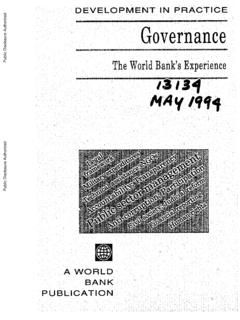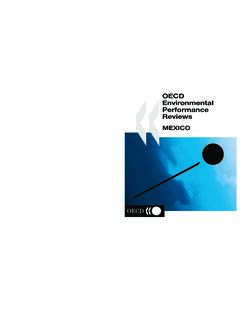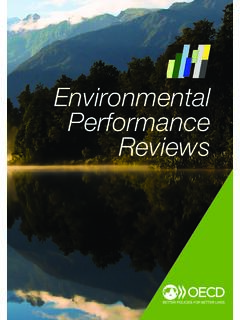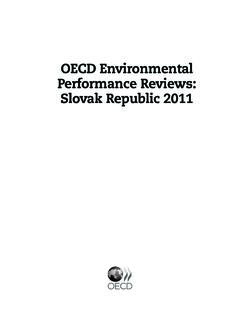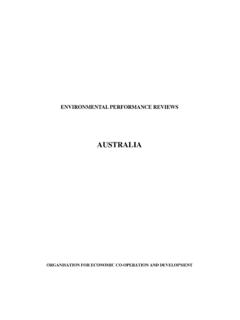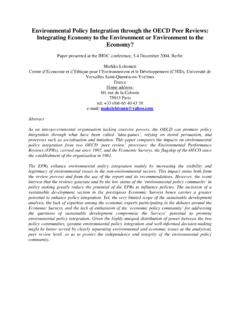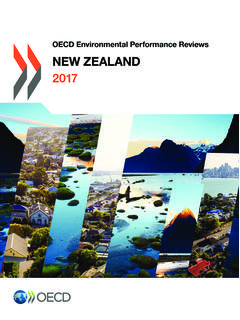Transcription of ENVIRONMENT TRATEGY PAPERS NO Public Environmental ...
1 Public EnvironmentalExpenditure Reviews (PEERS)Experience and Emerging PracticeMay 2003 ENVIRONMENTSTRATEGY PAPERSNO. 7 AuPhil Swanson and Leiv LundethorsACountryEnvironmentalAnalysisP ublicationPublic Disclosure AuthorizedPublic Disclosure AuthorizedPublic Disclosure AuthorizedPublic Disclosure AuthorizedPublic Disclosure AuthorizedPublic Disclosure AuthorizedPublic Disclosure AuthorizedPublic Disclosure AuthorizedThe International Bank for Reconstructionand Development/THE WORLD BANK1818 H Street, , 20433, in the United States of AmericaFirst printing May 2003In 2001, the World Bank completed the comprehensive two-year process of preparing its ENVIRONMENT Strategy,Making Sustainable Commitments: An ENVIRONMENT Strategy for the World Bank.
2 It was endorsed by the Bank sBoard of Directors and published in October 2001. The ENVIRONMENT Strategy Paper series includes reportsprepared to facilitate implementation of the ENVIRONMENT Strategy emphasizes the need to strengthen the analytical foundation of Environmental work atthe country level. Country Environmental Analysis (CEA) has been identified as one of the key environmentaldiagnostic tools for systematically evaluating the Environmental priorities of development and poverty reductionstrategies in client countries, the Environmental implications of key policies, and countries institutional capacityand performance to address their report, together with other PAPERS on various aspects of CEA, was prepared as part of the stocktakingexercise for developing guidance on CEA.
3 The recommendations made in this paper represent the views of theauthors and not those of the World and AbbreviationsxiExecutive Summary1 Chapter 1: Introduction1 Public Expenditure Management1 Environmental Management2 PEERs in the CEA Context5 Chapter 2: Experience with PERs and Their Relevance for PEERs5 PER Best Practice 7 Coordination of PEERs with PERs9 Chapter 3: Experience with PEERs9 World Bank PEERs16 Outside the World Bank20 Conclusions23 Chapter 4: Definition and Typology of Environmental Expenditures23 OECD Definition and Classification Systems31 World Bank35 Toward a Definition and Typology of Environmental Expenditure for PEERs45 Chapter 5: Main Elements of a Guidance Note45 Creating an Expenditure Database46 Allocation47 Magnitude and Trends49 Efficiency and QualityivEnvironment Strategy PapersPublic Environmental Expenditure Reviews (PEERs) Experience and Emerging Practice51 Other Issues55 Chapter 6: Suggested Areas for Further WorkAppendices57 Appendix A: Examples of Environmental Projects from the Asia EnvironmentalStrategy59 Appendix B.
4 OECD Checklists for Measuring performance of Public EnvironmentalExpenditure Management59 Checklist 1. performance in terms of Environmental effectiveness60 Checklist 2. performance in terms of fiscal prudence62 Checklist 3. performance in terms of management efficiency65 Appendix C: Environmental Financial Flows to Developing Countries71 Appendix D: Guidelines for Using World Bank Thematic Codes Regarding Environmentand Natural Resources Management75 Notes79 ReferencesBoxes18 BOX 1. Examples of common analyses carried out in OECD EPRs68 BOX Methodological note regarding use of the CRS databaseFigures3 Figure 1. Key building blocks of the CEA65 Figure Direction of net official flows, 1998/9969 Figure C.
5 2. Estimates of ENVIRONMENT -related ODA commitments as a percentageof total ODA using four CRS purpose code Environmental screensTables17 Table 1. Summary of issues covered by World Bank PEERs27 Table 2. Environmental protection purpose codes in the Creditor Reporting System29 Table 3. Natural resource management activities and exploitation activities, SEEA classification40 Table 4. Draft examples of accounts for the various dimensions of environmentalexpenditure66 Table Official development finance (ODF) from DAC member countries and multi-lateral agencies to aid recipients, 1993 200067 Table Four Environmental screens based on CRS purpose codes68 Table Environmental aid as a share of total aid, 1990 and 1995 2000vThe existence of externalities, marketfailures, and complex transboundaryand transgenerational issues linkedwith Environmental challenges means thatpublic sector institutions have an importantrole to play in Environmental expenditures and their effective man-agement are key aspects of a country s envi-ronmental policy, regulatory, and part of country-level Environmental analy-sis.
6 This report examines the definitions andclassification frameworks for environmentalexpenditure that have been used outside andwithin the World Bank, reviews experiencewith PEERs, and outlines a methodologicalframework for carrying out PEERs .Among the international tools reviewed are thepollution abatement and control (PAC) frame-work developed by the Organisation forEconomic Co-operation and Development(OECD), the Creditor Reporting System (CRS),and the Eurostat Classification of Environmen-tal Production Activities and Expenditure(CEPA). In addition, the report summarizesfindings of a review of 10 World Bank report provides a definition for PEER, anddiscusses the principal recommendationsregarding procedures for conducting a PEERand some of the methodological issues andproblems likely to be encountered.
7 Issuescovered include policy priorities, the spendingenvelope, expenditure allocation, magnitudesand trends, international and regional com-parisons, expenditure efficiency and quality,program-level and project-level analysis,potentially environmentally damaging subsi-dies, and foreign aid. The report concludeswith a list of suggested areas for further paper was prepared as part of thework program of the Strategy Team ofthe World Bank s ENVIRONMENT Depart-ment (ENV) under the guidance of MagdaLovei, lead Environmental economist and teamleader. It is part of a broader effort to learnfrom experience and help develop guidance forapplying country Environmental analysis moresystematically in the Bank s client work was coordinated by Poonam Pillai(ENV), who also provided inputs and authors of the study are Phil Swanson andLeiv Lunde; both are affiliated with the ECONC enter for Economic Analysis, Norway.
8 Theyare grateful for interviews with the followingWorld Bank staff: Richard Allen, CarterBrandon, Rob Crooks, Adriana Damianova,Peter Dewees, Giovanna Dore, Kirk Hamilton,Hans Olav Ibrek, Andreas Liebenthal, MagdaLovei, Poonam Pillai, Stefan Schwager, andVinaya Swaroop. The paper benefited frompeer review and comments by World Bankstaff (Carter Brandon, Robert Crooks, AdrianaDamianova, Giovanna Dore, Kirk Hamilton,and Anil Markandya) and OECD staff (MyriamLinster and Grzegorz Peszko). The authorsthank Nancy Levine, Rita Lohani, and NanakoTsukahara for editorial assistance and JimCantrell for design and are due to the governments of Den-mark and Norway for their generous financialsupport for the preparation and publication ofthis and AbbreviationsAFRSub-Saharan Africa RegionCAScountry assistance strategyCEAcountry Environmental analysisCEPAC lassification of Environmental Protection Activities and Expenditure (Eurostat/UNECE)COFOGC lassification of the Functions of GovernmentCRSC reditor Reporting System (OECD/DAC)DACD evelopment Assistance Committee (of the OECD)
9 EAPE nvironmental Action Programme for Central and Eastern EuropeEASESEast Asia ENVIRONMENT and Social Development Unit (World Bank)ECSSDE nvironmentally and Socially Sustainable Development Europe and Central Asia (World Bank)EFSenvironmental financing strategyEPERE nvironmental Protection Expenditure and Revenues (OECD/Eurostat questionnaire)EPRenvironmental performance reviewESWeconomic and sector workEUEuropean UnionGDPgross domestic productIMFI nternational Monetary FundISICI nternational Standard Industrial Classification of All Economic ActivitiesNACES tatistical Classification of Economic Activities in the European CommunityNEAP national Environmental action planNEMAP national Environmental management and action planNGOnongovernmental associationOAofficial assistanceODAofficial development assistanceOECDO rganisation for Economic Co-operation and DevelopmentxEnvironment Strategy PapersPublic Environmental Expenditure Reviews (PEERs)
10 Experience and Emerging PracticeOFAofficial development financeOOFother official flowsPACpollution abatement and controlPEEM Public Environmental expenditure managementPEER Public Environmental expenditure reviewPEMpublic expenditure managementPEIR Public expenditure and institutional reviewPERpublic expenditure reviewPRSP poverty reduction strategy paperR&Dresearch and developmentSEEAS ystem of Integrated Environmental and Economic AccountingSERIEEE uropean System for the Collection of Economic Information on the EnvironmentSSPR structural and social policies reviewUNECEU nited Nations Economic Commission for EuropeWPEPW orking Party on Environmental performance (OECD)WRIW orld Resources InstitutexiExecutive SummaryThe existence of externalities, marketfailures, and complex transboundaryand transgenerational issues linkedwith Environmental challenges means thatpublic sector institutions have an importantrole to play in Environmental expenditures and their effective man-agement are key aspects of a country s envi-ronmental policy, regulatory, and institutionalframework, since most policies are linked to aneed for Public expenditure of some , Public Environmental expendi-ture review (PEER) can be an important part ofcountry Environmental analysis (CEA).






